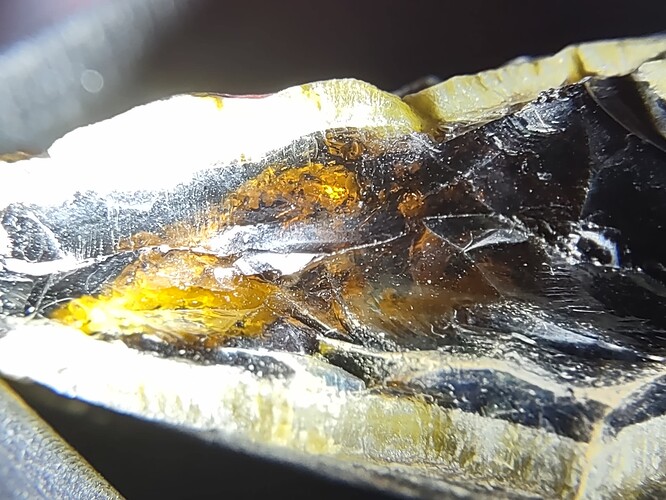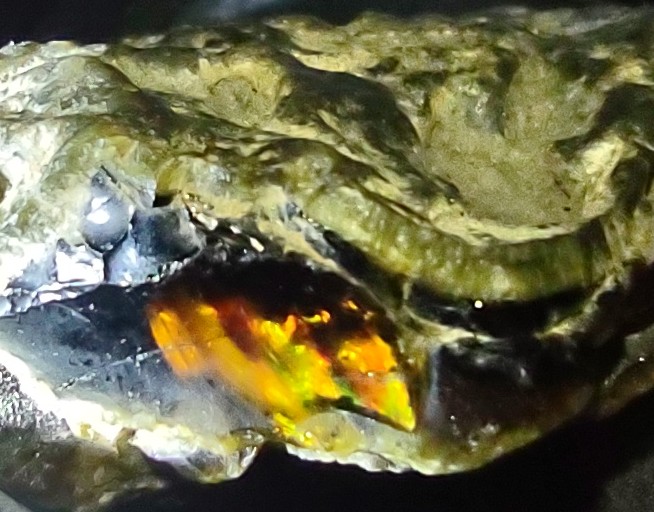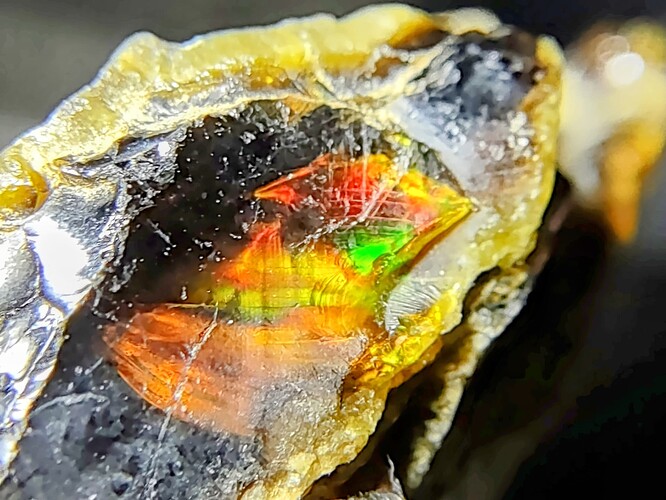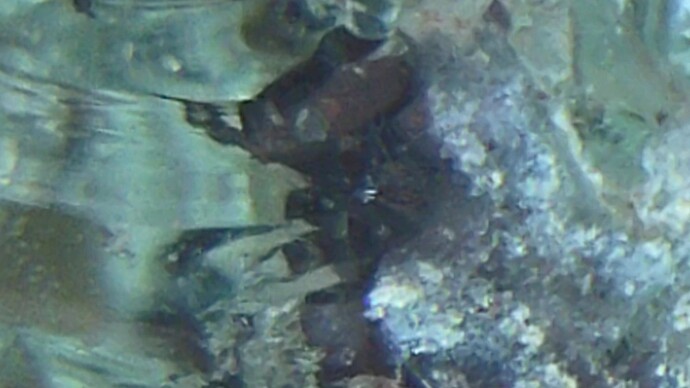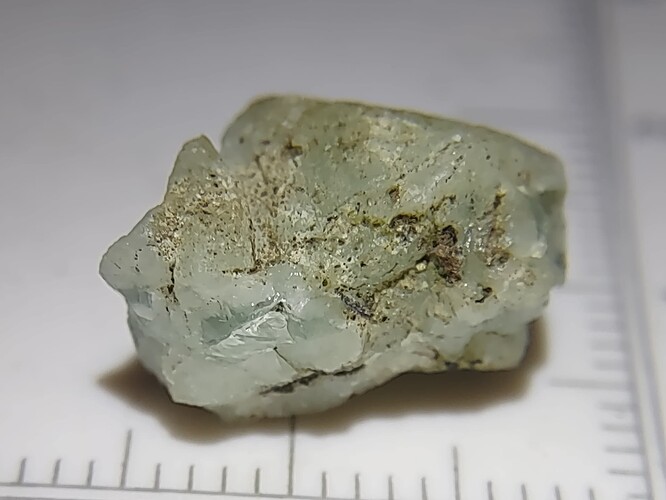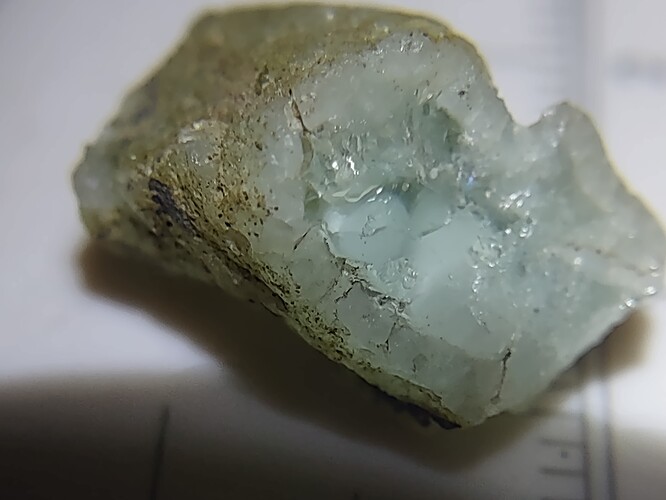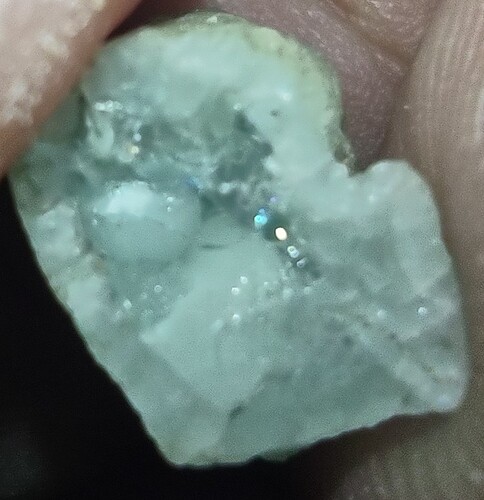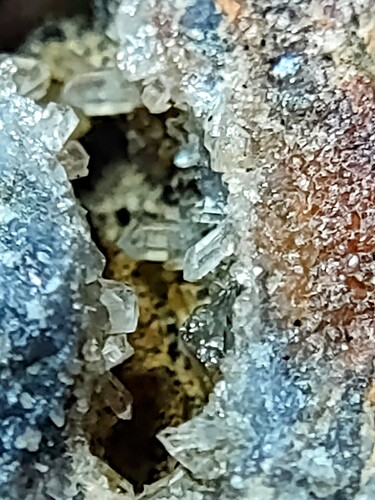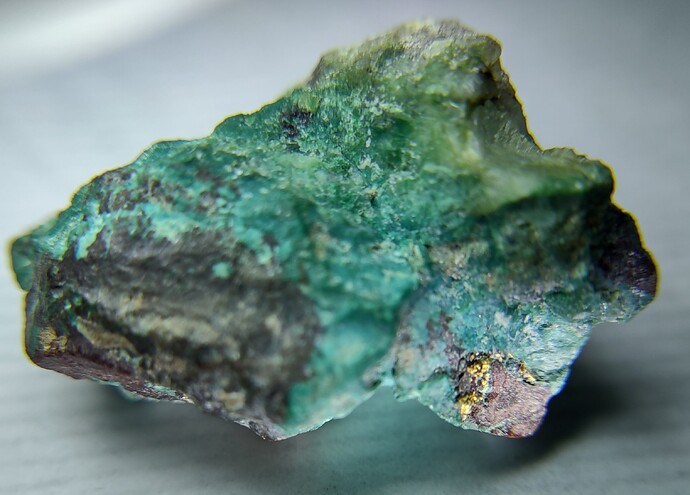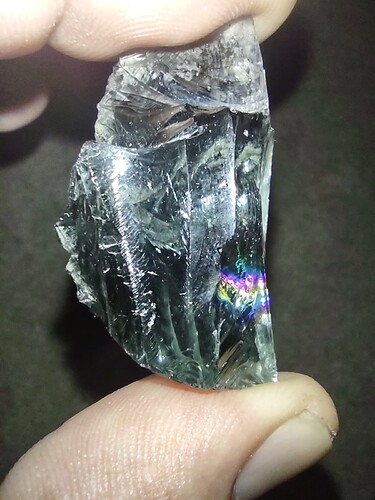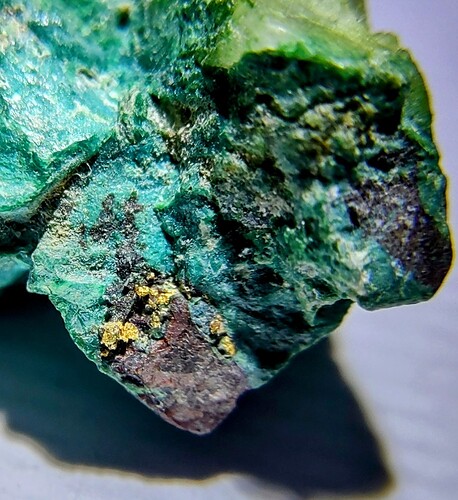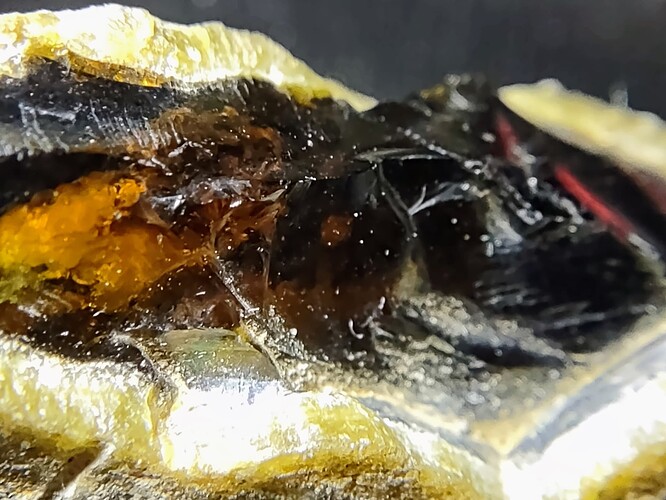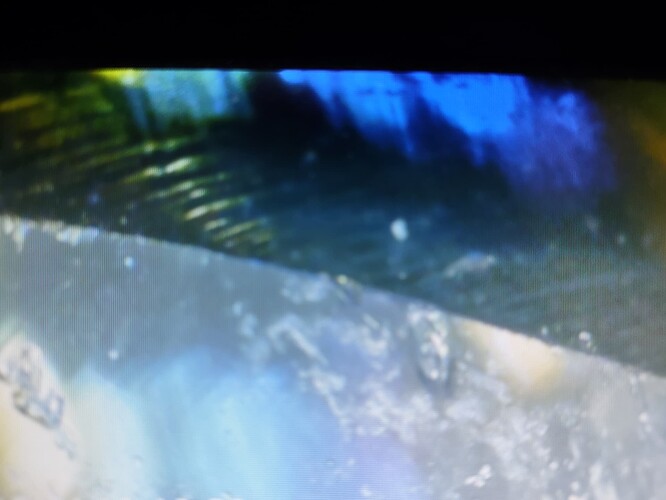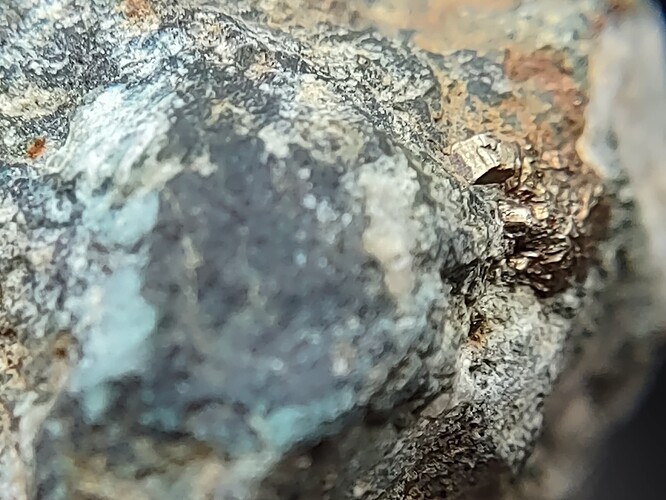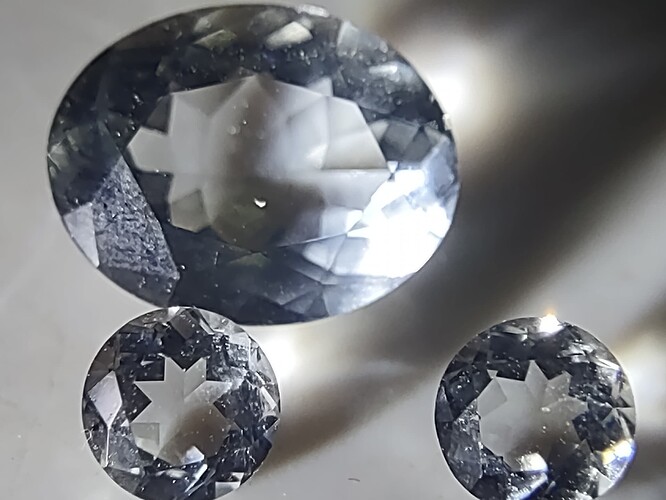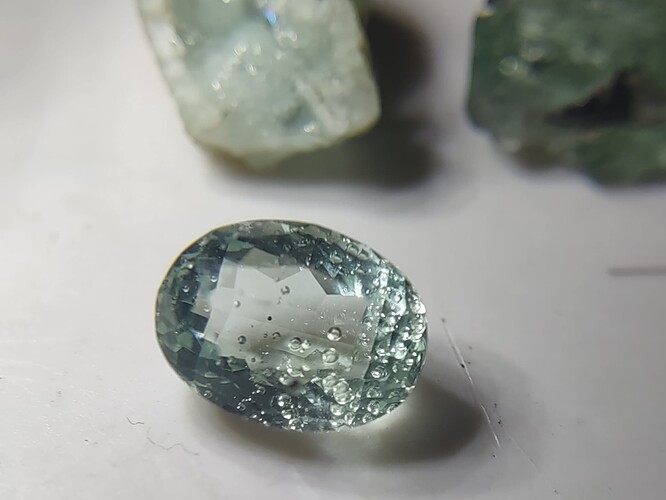Was wondering what would this type of opal be called and what the best description of the color bar would be called? It appears to have something fossilized inside, but is difficult for me to make out. Poasibly like a fossilized mollusk.
Kind of an unusual color. Don’t think I’ve ever seen one like this. Where did it come from?
The colors are fabulous. What size is the specimen?
Without seeing the stone itself irl I would say broadflash/flagstone and probably even flashfire? The last one if the fire seems to ‘follow’ the eye when moving the stone.
… and as to its origin. You are the one who bought it: didn’t it come with the name of the field and/or place of origin? If not: at first glance it looks like Wyoming petrified wood to me. Pieces having much fire are less common and mostly smaller. So then it would just a couple of centimeters max? Than skip the flashfire idea I came up with earlier…
In each case: nice piece. Have it examined and if indeed it turns out to been wood opal: don’t cut it. Would result in it not being regarded as being a fossil anymore.
Thanks for the info. I’m glad you like it, this one is a 115ct opalized fossil, from Washington state. It shows the color bar on one side and a what appears to be a fossilized something through the other. I think another 80ct piece found nearby was part of this one before. FlashFire, or flagstone? The color bar side is about 1.5in wide. The side showing the fossil is a little bigger but still trying to make out what type of fossil. Possibly a mollusk/clam. www.ebgemshop.com if you want to see more pics. Anyone have an idea how to value this piece? Thanks for the advice to leave it uncut. What about removing the matrix? I wouldn’t trust myself for that. Any suggestions where I might take this in for studying?
Looks like ammolite to me.
It could be ammolite, though it seems opalized differently than others I’ve seen. The less colorful pic is of what might be a clam siphon? Which seems likely given the shape is similar to a slightly deformed mollusk.
Well… having looked up the site: it tells us it being a fossil. The vendor himself does not mention the place of origin ( or must have overlooked it completely?). No details as to determine it actually is a confirmed fossil…
Knowing opal settles in voids from the outside in, might not be deformed as much as thought it is, would it have been an oyster or something similar. I would say the opal might have filled the void in 2 stages (3 even?): the first being filling just part with common opal and then gem opal moved in. Any claim as to organic matter being opalized I would say is highly questionable, because it is the first to disappear. There are loads of non-fossil opals having the same features, so I would say: artefact. What ís clear is that the entire outline is different, so: yes, fossil. Not an expert in what species.
The matrix: not to be removed or not removed as a whole. It refers to the field of origin and removel might damage the specimen. Ask an fossil expert what to do and do nót try doing it yourself, it being rare. Can only destroy it one time.
And well… as for the price… without any detail about what we have discussed above nor giving details that apparently áre available, no certified verification either… the vendor comes up with a price of… 924,000.00
It is in the details, confirmed.
Yes, I realize it’s expensive. In part because if it’s an opalised fossil in black crystal opal, it is very rare. I can’t get it certified because nothing has been found in this part of Washington before and gem labs need to have something from a known source that is faceted to compare it to. Even if faceted, or cabbed they would still say it’s man-made glass because no data on this type of opal seems to exist. Where can this be taken to verify, or deny if it is a fossil?
Does anyone know of any gem lab in the world that can confirm if a rock is natural vs synthetic? None seem capable of this and refer to EVERY rock from a USGS geologist ancestors collection, as manmade glass, also. Just because a lab deems something man made, doesn’t mean it is. Usually they say, well it’s clear and has ‘bubbles’, it must be man-made. Even if it’s obsidian/natural glass, or opal, which all can be transparent and have bubbles.
Another piece of different color opal has other fossil-looking inclusions, in matrix which I’ve found in non-gem grade natural looking as possible, rocks and had scanning electron microscopy on these, asking to mainly tell me if it’s natural or not. They said it LOOKS NATURAL UNDER SCANNING ELECTRON MICROSCOPE, They aren’t gemologists though and can’t tell me what it is, and gemologists don’t believe me when I tell them it appears natural under scanning electron microscope. These pics below are from very similar material from th same area. One piece looks like glass with a fossil, the other is hopefully not going to be called glass, but they are almost certainly the same material. This is a new opal field but I can’t get a geologist to travel to Washington to confirm this and don’t even know what type of geologist can say what rocks are natural vs man-made. Is there a test, or analysis which can do differentiate natural vs manmade?
Please understand, I am not being belligerent or sarcastic, here. That price is well beyond a “typical” collector’s value for an unknown specimen. It needs to come with its own pedigree to justify that monetary investment.
It would be best to consult a paleontologist and a geologist. Unfortunately, I doubt you will find anyone from those fields, willing to stake their reputation certifying a specimen collected from the field without being witness, or have access to the field notes from their colleagues that were physically present at time of collection.
I have the highest respect for the gemology labs at GIA, GEM-A, and others. All are really good resources, nevertheless, something like this needs to be peer-reviewed, academically.
It should be taken to a Geology Department at a University near the local area of extraction. They would have the most comprehensive knowledge of the local geologic lithosphere.
Having said that, there is an unfortunate condition when engaging academia. You may run into same scenario as stated above with reputations being at stake. Most academia will not stick their reputation out on a limb, unless they are compensated and feel they can generate a defendable dossier for the subject in question. They most-likely will turn down the opportunity unless they have the motivation, interest, and time to pursue.
Commissioned research funds are the best encouragement. But not cheap.
Now for the bad news…
If the specimen is being claimed as a fossil, State and Federal regulations may apply depending on local and state laws. Here in the U.S., selling fossils need traceability or proof that a fossil specimen was not collected on federal, state or reservation land, or have the appropriate permits to do so. A mine claim could be used for that purpose.
From a liability standpoint, the seller, can be held accountable for compensation to the buyer, if sued for falsification, lack of information, or potential risk that the specimen was illegally mined or extracted on government provisioned lands. Not only would the seller be responsible for recompense of the purchase value. They would be held financially accountable for any fines and court costs levied in the case, on behalf of the government.
Without that pedigree, the seller is burdened with a huge financial risk. If the host business is not appropriately insured and bonded, the owner is personally responsible for any litigation proceedings.
Our alumni, Mr. Jeffery Bergman (@jbergman) has been tracking several litigation stories surrounding the Bahia and Beleza Emerald clusters, which I have been following with keen interest for a long time.
Here is one of his IGS articles: Is the 500-Pound Beleza Emerald Really Worth $280 million? - Gem Society
While searching for the original NatGeo video on the Bahia Emerald, I watched many years ago, I found this version: https://youtu.be/HgE_naVBTKQ?si=9ibkTaTbZ81iJFdG. The original documentary from NatGeo doesn’t seem to be available anywhere. ![]()
-Cheers!
Troy
Thank you as always Troy! I know I’m in need of advice on how to price these and have been really happy with the advice from this forum. Any suggestions would be great but I honestly feel these are extremely rare, and from a new location, and of excellent quality. Some with opalized inclusions. Others with gold occuring on, or next to either grandidierite, or some other color changing variety of stone. I honestly feel these are fine collectors items which may not be found anywhere else on earth. I have been told by the geochemical lab that did SEM that what he looked at very thoroughly was likely natural, in his opinion. And also likely contained gold in, or occuring on it. I know I’m not a professional, I really do appreciate your obvious experience and knowledge about all of this and hope we can meet someday.
I’ll look further into geologists, gemologists and nearby university affiliates, to see if anyone can make it to the claim. I still have to wonder if there is a conclusive test to prove if a stone is natural, or synthetic though?
Findings from our last few trips has me feeling positive that these are natural.
Thanks again!
Cheers!
Scott
Hi Scott, sorry for the delay, was wrapped up in a work cocoon the past few days.
They look natural to me!
Have you tested for hardness? Done a streak test? There are a few quick things you can do to help collect data on the material. For instance, some common opal types can be fluorescent.
I have a mine-run parcel of Welo Opal from Ethiopia, but these do not fluoresce under long-wave UV. I haven’t tried the shortwave UV yet… still need to get one of those. ![]()
However, they behave like typical Welo opal, which is a hydrophane material. It’s fairly porous and when submerged in water, the opal material becomes transparent and the play of color disappears.
After it dries out, the play of color returns and it regains its milky background. Freaked out a bit when I was cleaning them in water. Had a slight panic attack thinking I ruined the parcel… ![]()
Really going to be challenging making cabs with these… have to keep them cool during the process, so… there is that conundrum.
Dr. Arem and Mr. Clark co-wrote this really good article on Opal (in case you haven’t seen it). Opal Gems: Value, Price, and Jewelry Information - IGS
Which brings me to something else you mentioned. Those SEC Scanning Electron Microscope (SEM) measurements. Do you have the images / data results for these scans? SEM can definitely provide some clues on the structure of the material, inclusions, and detect the silicate spheres that generate the play of color. (see article above). As you stated, the SEM operators were not gemologists, but they were at least in the geology field, working for a geochemistry lab, and not a medical or biology lab, right?
Very curious to know what they observed.
Also, one of the specimens you posted images of on Aug 25th, looks a lot like a crystalized tree limb. I have a really good specimen that has similar characteristics. I will unpack it (just recently moved to new location) and will upload some images.
Cheers!
-Troy
P.S. Yes, it would be really cool to meet you sometime! Hopefully we can do that. Would like to meet the whole group here at IGS, if the opportunity was ever presented. ![]()
I would say its welo , defo not Australian opal !
Not sure about the USA, but there very few labs than can test and certify country of origin for opals .
Field of origin is another story altogether.
This place in Switzerland https://www.ssef.ch
does testing for opal country of origin.
But these tests are not cheap
Welcome to the world of opal certification haha.
Pains my opal business every day !!
Btw way group I am Martyn, nice to meet you all .
I sell Australian opal rough etc check it out see my shop www.roughblackopal.com
Good luck with the investigation ![]()
I’m really happy with the suggestions and questions from this forum. Can’t tell you how much I appreciate it. The suggestion to try SSEF sounds like a good one to try next. Your shop looks great btw! These are found in the US and are likely volcanic in origin. The hardness given by the lapidary was around 7 and seem very resistant to cracking. Not absorbing, or losing water and were found in an area where it’s constantly getting wet, then dry. The streak is white, or slightly grey. Short wave UV shows a milky blue to green color of one type of sample. I don’t know why it changes it’s fluorescence color and am wondering if some other dim light source was causing the greenish reaction. Those samples are trichroic changing from purple/blue to greenish to colorless. Makes me wonder if grandidierite is a possibility and if opal and grandidierite are at all similar, or occur near each other. The crystal formations in a previous post (the one that could possibly be crystallized tree branch) looks really similar to this same trichroic material that fluoresces blue-green.
It’s really beautiful faceted and has similar dispersion to diamond. Set side by side there is very little difference. I’ll include some pics as this is the material that’s throwing me off because it doesn’t look like opal, but I think it’s still a possibility. The geologist who did the SEM did a very thorough analysis, the lapidary/ materials scientist, was impressed. The main thing I wanted to know was if it’s natural. He said don’t hold him to it, but that it’s very likely natural and had gold in or on the rough. So, I’m assuming it’s similar to this deep blue gemmy looking material with cubic gold occuring on it, which doesn’t look like opalised material but I’m no expert at identification.
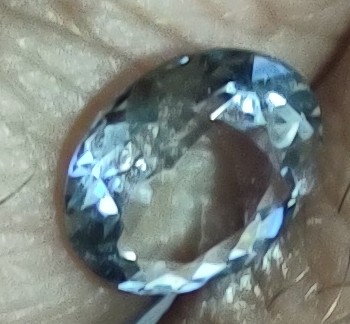
think this might help
https://www.nevadaopal.com/history
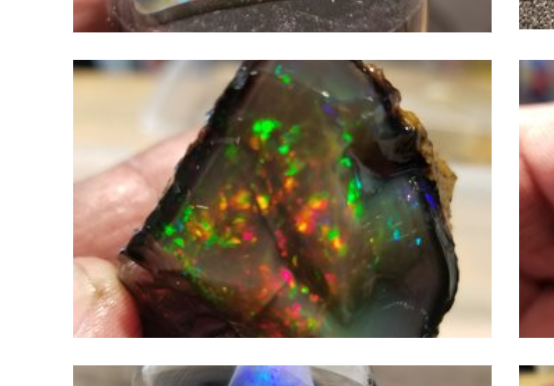
Scott. I believe you’ve got a condition known to scientists and it is called paralysis through analysis. If you have a good product or one that is unique please have the confidence to put it out on the market place at a price that your colleagues consider reasonable. If wrong the market will respond with no interest and no sales. if correct and you have a presented the product honestly and well then you can expect reward but perhaps not a bonanza. The above assumes you have done your market research to see who else may have similar products and at what price. I wish you luck.
Thanks again Ivan. I agree I’m stuck and that I need to start selling. I’m pretty sure this is unique, and I believe of excellent quality. I only know for sure that a few pieces are opal though and while I’m pretty sure much of the other is also, most people think it’s man-made glass, even when faceted. What would be a reasonable price point be? And what can I do to prevent being sued? I’ve already been dosed multiple times by people getting the location, and threatening my family to keep me away. Then told they’ll just wait until I go break the bank tryin to prove it’s natural before they claim it.
Is there a price point you, or anyone else here, might buy at? What types of black opal go for $20,000/Ct and what types go for $10/?
The few pieces I’ve be able to convince people are natural are truly unique and beautiful, likely opalised fossils. I can’t bring myself to sell those cheaply before knowing more about them and can’t get a decent price on the ones that look like glass. I’ve tried multiple universities, labs, jewelers and more. Not many seem interested and all but one small gem lab, and the geochemical lab that did SEM, say it looks natural, but can’t prove it. They tell me to take to a gem lab, where it’s always called man-made glass. Which makes me certain I’ll be sued if someone does buy any at a decent price. One lab says I need to submit 5 cut stones per year, and have a geologist/gemologist identify, package, and ship from the site. I guess this is my next step but I can’t get a geologist there. I was told to get a lawyer to help, they told me to visit their geologist who told me that the gems are glass, the gold is brass, and everything else is man-made. Then they dumped me, after they had the location, because I said some was collected by a family member who was a noted geologist and life long miner and I didn’t believe that literally EVERYTHING I took in was synthetic. They told me to get a surveyor there but to have an NDA. I had already been dumped by the lawyer, when the surveyor asked where to meet, then said he was going on vacation and couldn’t make it, after getting the location. I know this is a big find purely by all the shady things people, including lawyers, have done since finding it. Now there are people stealing my claim signs and squatting directly on the area i want to search and littering the entire site, making it tough to search the areas I want and making me wonder if I’m going to be shot or dosed again everytime I’m there.
I have seen similar colors and have a couple examples. All of the ones I have seen (and own) are from Australia. This is not to say these only come from Australia, but I know at least some do,
